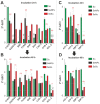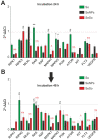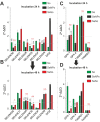Comparative Analysis of the Cytotoxic Effect of a Complex of Selenium Nanoparticles Doped with Sorafenib, "Naked" Selenium Nanoparticles, and Sorafenib on Human Hepatocyte Carcinoma HepG2 Cells
- PMID: 35743086
- PMCID: PMC9223423
- DOI: 10.3390/ijms23126641
Comparative Analysis of the Cytotoxic Effect of a Complex of Selenium Nanoparticles Doped with Sorafenib, "Naked" Selenium Nanoparticles, and Sorafenib on Human Hepatocyte Carcinoma HepG2 Cells
Abstract
Despite the use of sorafenib as one of the most effective drugs for the treatment of liver cancer, its significant limitations remain-poor solubility, the need to use high doses with the ensuing complications on healthy tissues and organs, and the formation of cell resistance to the drug. At the same time, there is more and more convincing evidence of the anticancer effect of selenium-containing compounds and nanoparticles. The aim of this work was to develop a selenium-sorafenib nanocomplex and study the molecular mechanisms of its anticancer effect on human hepatocyte carcinoma cells, where nanoselenium is not only a sorafenib transporter, but also an active compound. We have created a selenium-sorafenib nanocomplex based on selenium nanoparticles with size 100 nm. Using vitality tests, fluorescence microscopy, and PCR analysis, it was possible to show that selenium nanoparticles, both by themselves and doped with sorafenib, have a pronounced pro-apoptotic effect on HepG2 cells with an efficiency many times greater than that of sorafenib (So). "Naked" selenium nanoparticles (SeNPs) and the selenium-sorafenib nanocomplex (SeSo), already after 24 h of exposure, lead to the induction of the early stages of apoptosis with the transition to the later stages with an increase in the incubation time up to 48 h. At the same time, sorafenib, at the studied concentrations, began to exert a proapoptotic effect only after 48 h. Under the action of SeNPs and SeSo, both classical pathways of apoptosis induction and ER-stress-dependent pathways involving Ca2+ ions are activated. Thus, sorafenib did not cause the generation of Ca2+ signals by HepG2 cells, while SeNPs and SeSo led to the activation of the Ca2+ signaling system of cells. At the same time, the selenium-sorafenib nanocomplex turned out to be more effective in activating the Ca2+ signaling system of cells, inducing apoptosis and ER stress by an average of 20-25% compared to "naked" selenium nanoparticles. Our data on the mechanisms of action and the created nanocomplex are promising as a platform for the creation of highly selective and effective drugs with targeted delivery to tumors.
Keywords: apoptosis; calcium signaling; cancer; gene expression; necrosis; selenium nanoparticles; selenium–sorafenib nanocomplex; sorafenib.
Conflict of interest statement
The authors declare no conflict of interest.
Figures










Similar articles
-
Cytoprotective Properties of a New Nanocomplex of Selenium with Taxifolin in the Cells of the Cerebral Cortex Exposed to Ischemia/Reoxygenation.Pharmaceutics. 2022 Nov 16;14(11):2477. doi: 10.3390/pharmaceutics14112477. Pharmaceutics. 2022. PMID: 36432668 Free PMC article.
-
Ca2+-Dependent Effects of the Selenium-Sorafenib Nanocomplex on Glioblastoma Cells and Astrocytes of the Cerebral Cortex: Anticancer Agent and Cytoprotector.Int J Mol Sci. 2023 Jan 26;24(3):2411. doi: 10.3390/ijms24032411. Int J Mol Sci. 2023. PMID: 36768736 Free PMC article.
-
PEG-nanolized ultrasmall selenium nanoparticles overcome drug resistance in hepatocellular carcinoma HepG2 cells through induction of mitochondria dysfunction.Int J Nanomedicine. 2012;7:3939-49. doi: 10.2147/IJN.S30940. Epub 2012 Jul 23. Int J Nanomedicine. 2012. PMID: 22915845 Free PMC article.
-
Molecular Mechanisms of the Therapeutic Effect of Selenium Nanoparticles in Hepatocellular Carcinoma.Cells. 2024 Jun 26;13(13):1102. doi: 10.3390/cells13131102. Cells. 2024. PMID: 38994955 Free PMC article. Review.
-
Current status of sorafenib nanoparticle delivery systems in the treatment of hepatocellular carcinoma.Theranostics. 2021 Mar 13;11(11):5464-5490. doi: 10.7150/thno.54822. eCollection 2021. Theranostics. 2021. PMID: 33859758 Free PMC article. Review.
Cited by
-
Synthesis and biological evaluation of titanium dioxide/thiopolyurethane composite: anticancer and antibacterial effects.BMC Chem. 2024 Feb 17;18(1):35. doi: 10.1186/s13065-024-01138-x. BMC Chem. 2024. PMID: 38368376 Free PMC article.
-
Cytoprotective Properties of a New Nanocomplex of Selenium with Taxifolin in the Cells of the Cerebral Cortex Exposed to Ischemia/Reoxygenation.Pharmaceutics. 2022 Nov 16;14(11):2477. doi: 10.3390/pharmaceutics14112477. Pharmaceutics. 2022. PMID: 36432668 Free PMC article.
-
Sorafenib and Doxorubicin Show Synergistic Effects in Human and Canine Osteosarcoma Cell Lines.Int J Mol Sci. 2022 Aug 19;23(16):9345. doi: 10.3390/ijms23169345. Int J Mol Sci. 2022. PMID: 36012610 Free PMC article.
-
Ca2+-Dependent Effects of the Selenium-Sorafenib Nanocomplex on Glioblastoma Cells and Astrocytes of the Cerebral Cortex: Anticancer Agent and Cytoprotector.Int J Mol Sci. 2023 Jan 26;24(3):2411. doi: 10.3390/ijms24032411. Int J Mol Sci. 2023. PMID: 36768736 Free PMC article.
-
The Role of Selenium Nanoparticles in the Treatment of Liver Pathologies of Various Natures.Int J Mol Sci. 2023 Jun 23;24(13):10547. doi: 10.3390/ijms241310547. Int J Mol Sci. 2023. PMID: 37445723 Free PMC article. Review.
References
-
- Wilhelm S.M., Carter C., Tang L., Wilkie D., McNabola A., Rong H., Chen C., Zhang X., Vincent P., McHugh M., et al. BAY 43-9006 exhibits broad spectrum oral antitumor activity and targets the RAF/MEK/ERK pathway and receptor tyrosine kinases involved in tumor progression and angiogenesis. Cancer Res. 2004;64:7099–7109. doi: 10.1158/0008-5472.CAN-04-1443. - DOI - PubMed
MeSH terms
Substances
Grants and funding
LinkOut - more resources
Full Text Sources
Miscellaneous

